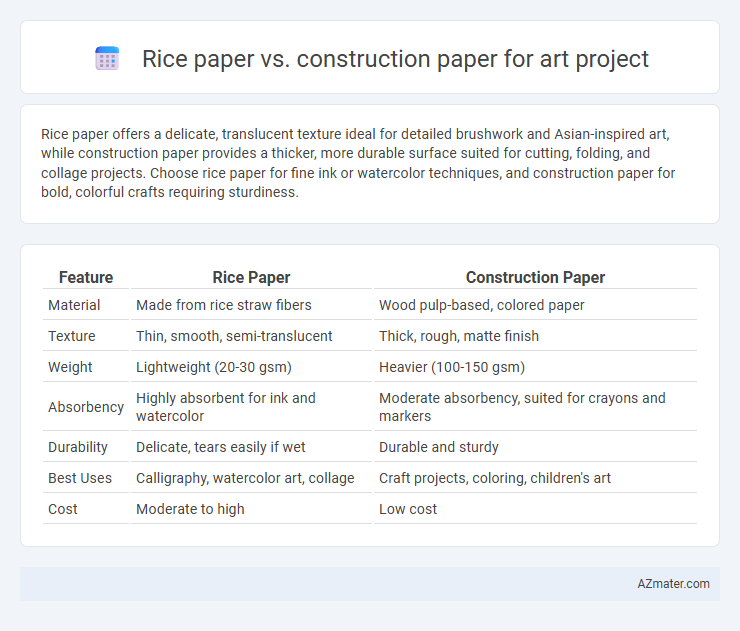Rice paper offers a delicate, translucent texture ideal for detailed brushwork and Asian-inspired art, while construction paper provides a thicker, more durable surface suited for cutting, folding, and collage projects. Choose rice paper for fine ink or watercolor techniques, and construction paper for bold, colorful crafts requiring sturdiness.
Table of Comparison
| Feature | Rice Paper | Construction Paper |
|---|---|---|
| Material | Made from rice straw fibers | Wood pulp-based, colored paper |
| Texture | Thin, smooth, semi-translucent | Thick, rough, matte finish |
| Weight | Lightweight (20-30 gsm) | Heavier (100-150 gsm) |
| Absorbency | Highly absorbent for ink and watercolor | Moderate absorbency, suited for crayons and markers |
| Durability | Delicate, tears easily if wet | Durable and sturdy |
| Best Uses | Calligraphy, watercolor art, collage | Craft projects, coloring, children's art |
| Cost | Moderate to high | Low cost |
Introduction: Rice Paper vs Construction Paper in Art Projects
Rice paper offers delicate texture and translucency ideal for detailed brushwork and calligraphy, enhancing fine art projects with an ethereal quality. Construction paper provides vibrant colors and sturdy thickness suitable for bold, layered collage work and children's crafts, ensuring durability and ease of handling. Choosing between rice paper and construction paper depends on the desired aesthetic, technique, and project durability requirements.
Material Composition and Origins
Rice paper is traditionally made from the fibers of the rice plant, mulberry bark, or other natural fibers, offering a smooth, translucent texture ideal for detailed ink and watercolor art. Construction paper, primarily composed of wood pulp and dyed with synthetic pigments, is thicker, more opaque, and designed for durability in crafting and children's projects. The origins of rice paper trace back to East Asian calligraphy and painting traditions, while construction paper was developed in the 20th century as a versatile, affordable material for educational use.
Texture and Surface Qualities
Rice paper features a delicate, translucent texture that absorbs ink and paint smoothly, enhancing fine brushwork and detailed line art. Construction paper offers a rougher, more fibrous surface ideal for bold, textured effects and layering techniques. The unique surface qualities of each influence paint adhesion and overall visual impact in art projects.
Color Variety and Opacity
Rice paper offers a subtle range of pastel and natural hues with high translucency, allowing light to pass through and creating layered, delicate effects in art projects. Construction paper provides a broad spectrum of vibrant, saturated colors and is highly opaque, ideal for bold, solid applications requiring strong color visibility. Choosing between the two depends on the desired visual impact, with rice paper enhancing texture and layering through translucency, while construction paper delivers vivid, intense color coverage.
Strength and Durability
Rice paper offers delicate texture suited for detailed ink and watercolor work but lacks tensile strength, making it prone to tearing under stress. Construction paper, composed of thicker fibers, provides greater durability and resistance to bending or breaking, ideal for projects requiring structural integrity. For art projects needing longevity and handling, construction paper outperforms rice paper in terms of strength and durability.
Compatibility with Art Supplies
Rice paper exhibits superior compatibility with water-based media such as watercolor, ink, and acrylics due to its smooth texture and absorbent qualities, preventing bleeding and allowing for fine detail work. Construction paper, with its coarse surface and lower resistance to moisture, often warps or deteriorates when exposed to heavy wet media, making it better suited for dry supplies like crayons, markers, and colored pencils. Artists seeking durability and precision with mixed media generally prefer rice paper for projects requiring both wet and dry art supplies.
Techniques Best Suited for Each Paper
Rice paper excels in techniques such as brush painting, calligraphy, and watercolor washes due to its smooth texture and absorbency, allowing delicate ink flow and subtle color blending. Construction paper is ideal for collage, cutouts, and mixed media projects because of its sturdiness and variety of vibrant colors that hold adhesives well and maintain shape during layering. Choosing rice paper enhances fluid artistic strokes and fine detailing, while construction paper supports tactile, layered, and bold, graphic compositions.
Cost and Accessibility
Rice paper offers a lightweight and translucent texture at a higher cost, often preferred for delicate or detailed art projects, while construction paper is significantly more affordable and widely accessible in various colors and thicknesses. Rice paper can be harder to find in standard art supply stores and may require specialty retailers or online ordering. Construction paper's availability in most school and craft shops makes it a budget-friendly option for large-scale or everyday art projects.
Environmental Impact and Sustainability
Rice paper demonstrates superior environmental sustainability compared to construction paper, as it is typically made from natural fibers such as hemp, mulberry, or rice straw, which are renewable and biodegradable. Construction paper often involves the use of chemical dyes and bleaching agents, contributing to higher pollution levels and slower decomposition rates. Choosing rice paper reduces the ecological footprint of art projects by minimizing toxic waste and promoting the use of renewable, eco-friendly materials.
Choosing the Right Paper for Your Art Project
Rice paper offers a delicate texture and translucent quality ideal for watercolor, ink, and calligraphy, providing smooth absorption and subtle color blending. Construction paper is thicker, with a rough surface that suits crayons, pastels, and collage, offering durability and vibrant color retention. Selecting the right paper depends on the medium used and the desired effect, ensuring optimal adherence, texture, and visual outcome in your art project.

Infographic: Rice paper vs Construction paper for Art project
 azmater.com
azmater.com